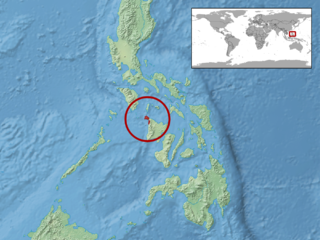The Bukidnon woodcock, or Philippine woodcock is a medium-sized wader. It was only described as new to science as recently as 2001, although the initial specimens had been collected on Luzon in the 1960s, these were originally misidentified as Eurasian woodcock specimens. It was not until the bird was heard calling in 1993, and new specimens obtained on Mindanao in 1995, that it was realised that the species was new. It is listed as Least Concern by the IUCN.

The black-spotted sticky frog is a small frog with a black spot just in front of each of its hind legs. It releases a sticky substance when threatened, thereby making it an unpleasant meal for predators, allowing it to escape from harm.
The Cabalian frog or Leyte slender stream frog is a species of frog in the family Ranidae. It is endemic to the islands of Leyte, Samar, and Mindanao in the Philippines. It inhabits undisturbed and disturbed streams and rivers in lower montane and lowland forests. It is threatened by habitat loss through deforestation and habitat conversion to agriculture as well as by the pollution due to agricultural run-off.

Sanguirana sanguinea is a species of frog in the family Ranidae. It is found in Sulawesi, Indonesia and Palawan, the Philippines.

The frilled tree frog, rough-armed tree frog, or Southeast Asian tree frog is a species of frog in the family Rhacophoridae found in Brunei, Cambodia, India, Indonesia, Malaysia, Myanmar, the Philippines, Thailand, and Vietnam. Its natural habitats are subtropical or tropical moist lowland forest, subtropical or tropical swamps, subtropical or tropical moist shrubland, rivers, swamps, freshwater marshes, and intermittent freshwater marshes. It is threatened by habitat loss.
Leptomantis bimaculatus is a species of frog in the moss frog family (Rhacophoridae). Described by Wilhelm Peters in 1867, it is endemic to the Philippines. There, it is known to occur on the islands of Bohol, Mindanao, and in the south of Luzon; it might also be found on other islands as its known range brackets the main chain of the Philippines archipelago.

The harlequin tree frog is a species of frog in the family Rhacophoridae found in Brunei, Indonesia, Malaysia, Thailand, and the Philippines. Its natural habitats are subtropical or tropical moist lowland forest, subtropical or tropical moist montane forest, freshwater marshes, and intermittent freshwater marshes. It is threatened by habitat loss.

Sanguirana everetti is a species of true frog. It is endemic to the island of Mindanao in the Philippines.

Sanguirana luzonensis, also known as the Luzon frog, is a species of true frog, family Ranidae. It is endemic to the island of Luzon, the Philippines. It occurs in swift-flowing, cool mountain streams and rivers in montane rainforest at elevations up to 2,000 m (6,600 ft). It is very common in many habitats, although it is suspected to be declining because of habitat loss and deterioration.

Sanguirana igorota is a species of true frog, family Ranidae. It is endemic to Cordillera Central of the island of Luzon, Philippines. Its closest relative is Sanguirana luzonensis, and it has even been considered synonym of that species; a later study suggests still unresolved relationships between S. igorota, S. luzonensis, and S. tipanan. Common name Taylor's Igorot frog has been coined for this species.

Sphenomorphus fasciatus , the banded sphenomorphus, is a species of skink endemic to the Philippines. It is oviparous and grows to about 70 mm (2.8 in) in snout–vent length.

Sanguirana is a genus of true frogs found in the Malay Archipelago, including the Philippines, the Maluku Islands, Sulawesi, and Seram.

Gekko gigante, also known as the Gigante narrow-disked gecko or the Gigante gecko, is a species of gecko found in the Gigantes Islands in Carles, Iloilo Philippines.

Gekko ernstkelleri is a species of gecko, a lizard in the family Gekkonidae. The species is endemic to the Philippines.

Parvoscincus leucospilos, the white-spotted sphenomorphus, is a species of skink endemic to the Philippines. It is found between 300 and 1,200 m above sea levels in the forests of central and southern Sierra Madre Mountain Range of Luzon Island. This skink hides under rocks or in debris in the banks of streams and rivers. When threatened by predators, such as snakes, it may dive and stay under water for a long time.

Platymantis biak, also known as the Luzon limestone forest frog, is a species of frog in the family Ceratobatrachidae. It is endemic to the island of Luzon, the Philippines, where it is known from the Biak-na-Bato National Park, its type locality, and from the immediate vicinity of the park. The specific name biak is Tagalog meaning "crevice" or "crack" and refers to the preferred limestone karst habitat at the type locality.
Platymantis quezoni is a species of frog in the family Ceratobatrachidae. It is endemic to the Philippines. Its type locality is in the Quezon Protected Landscape, where it is found in limestone karst habitats. It may also be found in limestone karst habitats in Bondoc Peninsula.

The Philippine slender gecko is a species of gecko. It is endemic to the Philippines.

Pseudogekko compresicorpus, also known as the Philippine false gecko or cylindrical-bodied smooth-scaled gecko is a species of geckos. It is endemic to the Philippines.
Rabor's short-legged skink is a species of skink endemic to the Philippines.
















